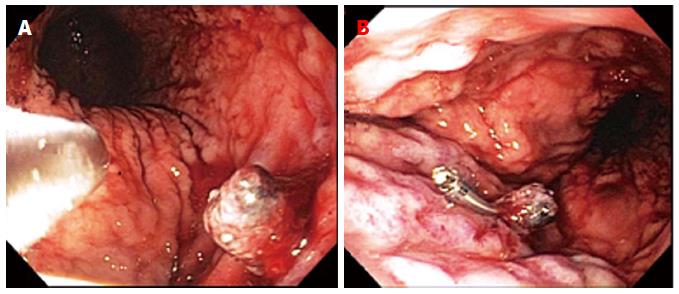Copyright
©The Author(s) 2015.
World J Gastrointest Endosc. Apr 16, 2015; 7(4): 295-307
Published online Apr 16, 2015. doi: 10.4253/wjge.v7.i4.295
Published online Apr 16, 2015. doi: 10.4253/wjge.v7.i4.295
Figure 3 An 88-year-old woman with prior bleeding duodenal ulcer 40 years earlier, and actively administered aspirin, presented with acute onset of hematemesis and melena, with an acute decline in the hemoglobin level from 11.
2 g/dL to 9.2 g/dL. Esophagogastroduodenoscopy revealed an actively oozing, darkly red, 8-10 mm wide, raised, lesion without surrounding erosions or ulceration that was actively oozing in the gastric cardia (A), findings characteristic of a Dieulafoy lesion. The lesion was first injected with 7 mL of epinephrine (1:10000 solution), followed by successful placement of a single hemoclip around the protruding vessel (B), with cessation of active oozing. The patient was discharged three days later with no evidence of recurrent bleeding during the hospitalization.
- Citation: Nojkov B, Cappell MS. Gastrointestinal bleeding from Dieulafoy’s lesion: Clinical presentation, endoscopic findings, and endoscopic therapy. World J Gastrointest Endosc 2015; 7(4): 295-307
- URL: https://www.wjgnet.com/1948-5190/full/v7/i4/295.htm
- DOI: https://dx.doi.org/10.4253/wjge.v7.i4.295









